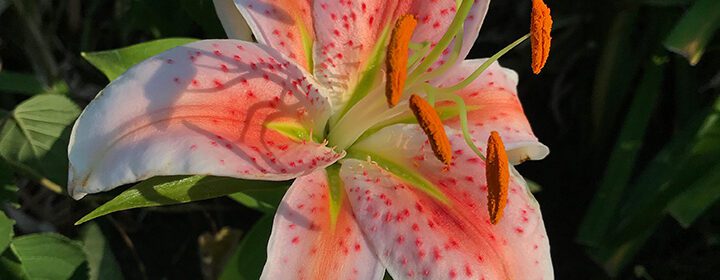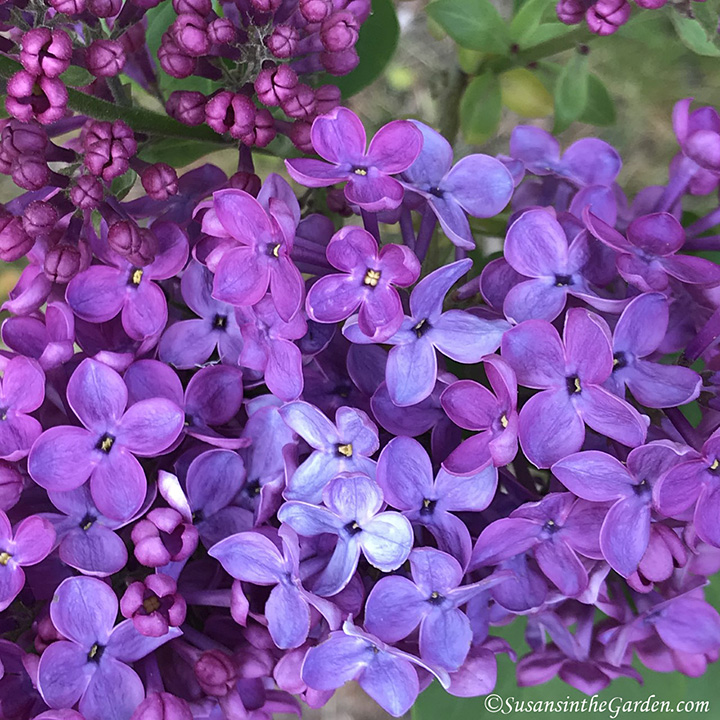April 17 Column: The Scented Garden

I’ve been looking forward to writing this column for quite a while! How would you like to create your very own scented garden, filled with wonderful fragrances throughout the growing season? That has sounded pretty good to me!
In my column, I look at the various components for a scented garden and make lots of suggestions. I’m hoping you’ll find a few fragrant plants to add to your own garden. You can read my column underneath the two videos below.
If you’re wondering what that breathtakingly beautiful flower is in the photo at the top, that is ‘Salmon Star’ Oriental lily. And its fragrance is out of this world!
In this week’s video, I show you how I plant my “gutter peas.” I’ve done two things differently: one is to add legume inoculant to each trench prior to planting the peas. The other is to support each of the rows on the south side. Vining plants have a tendency to grow toward the south so this just makes good sense to me. I hope you’ll enjoy the video:
Also, I thought I should embed the other gutter pea video that I created this year. It combines the two videos I shot last spring and within this week’s video, I refer to it. So if you’re looking for an explanation on what gutter peas are, how to sow the seeds and plant the seedlings VERY quickly (!), you’ll want to watch this next video:
Here is my column about creating your own scented garden:
By Susan Mulvihill
All gardens should be a celebration of the five senses. For example, colorful blossoms catch our attention and bring a smile to our faces. Ornamental grasses rustling in a breeze or the sound of a splashing water feature are music to our ears. Soft, fuzzy leaves invite us to touch them. Sweet berry harvests or sun-ripened cherry tomatoes tantalize our tastebuds. The delightful fragrances of flowers wafting through the air add to the experience.
The scents that we encounter in a garden are often associated with vivid memories from the past. They elevate our mood and make us slow down while we search for their source. When we consider how much fragrant flowers enhance our time outdoors, it’s a good idea to add scent to our list of priorities while shopping for plants.
In the spring, there are many plants that provide us with lovely scents. Lilacs are an obvious choice that immediately comes to mind. You can’t live in the Lilac City without having at least one lilac in your garden, right?
Common lilacs (Syringa vulgaris) are very hardy for our region and available in many pleasing colors. Our city’s namesake lilac, ‘Spokane’, has pink flowers. ‘Sensation’ features purple blossoms with white edges. The flowers on ‘President Lincoln’ are described as “Wedgewood blue” and have a captivating fragrance. All of these will grow 10 to 12 feet tall, although shorter lilac varieties are available as well. Be sure to visit the Lilac Garden in Manito Park for inspiration.
Mock orange (Philadelphus) is an early-blooming native shrub with white flowers and a light, citrusy scent. Star magnolias (Magnolia stellata) are showstoppers with their fragrant white flowers. They need plenty of room to accommodate their potential 15-foot height and 12-foot width but they are springtime standouts.
Two viburnums that are also fantastic springtime bloomers are ‘Burkwood’ (V. burkwoodii) and ‘Korean Spice’ (V. carlesii). Burkwood features white flower clusters and grows from 8 to 10 feet tall. Korean Spice is prized for its pink flowers and a more petite height of 6 feet. Both have incredible scents that will stop you in your tracks.
If you’ve got a spot for a vine, consider planting a honeysuckle (Lonicera). The flowers will attract hummingbirds and bees. Look for varieties noted for their fragrance such as ‘Scentsation’ or ‘Fragrant Cloud’. Others have more brightly-colored flowers but they don’t have much of a scent.
Sweet peas (Lathyrus odoratus) are also lovely vines. If you select fragrant varieties, it will be well worth the small amount of effort it takes to sow new seeds each spring. Great options include America, Black Knight, Cupani’s Original, Erewhon and Henri Eckford.
The blooms of herbaceous peonies are always a welcome sight in spring. Many have delightful fragrances, such as Sarah Bernhardt, Pink Hawaiian Coral, Festiva Maxima and Duchesse de Nemours. They are very easy to grow.
What about fragrant spring-flowering bulbs? Look for Dutch hyacinths, grape hyacinths, peony tulips and some daffodil varieties. Bearded irises, which grow from rhizomes, come in amazing color combinations. If you close your eyes when inhaling their fragrance, you’ll probably agree that it smells like lemon frosting.
As we move into summer, even more wonderful options are available. Roses are undoubtedly the most popular shrubs that bring unforgettable fragrances to the garden. The late David Austin spent his lengthy career breeding beautiful, easy-to-grow roses that have fantastic scents. Some of the best include ‘Abraham Darby’, ‘Bathsheba’, ‘Emily Bronte’, ‘Princess Alexandra of Kent’ and ‘Strawberry Hill’.
The tropical-looking foliage and exotic red flowers of ‘Aphrodite’ sweetshrub (Calycanthus chinensis) might lead one to think they couldn’t possibly grow in the Inland Northwest yet they are very hardy. In addition to their beautiful appearance, the blossoms give off a slightly fruity scent.
Oriental lilies are one of the most fragrant summer-blooming bulbs you can buy. Their stunningly beautiful blossoms are highly prized for their intoxicating scent. Some noteworthy varieties are ‘Casa Blanca’, ‘Stargazer’, ‘Salmon Star’ and ‘Josephine’. Best of all, the bulbs are very hardy and easy to grow.
Fragrant perennials include lavender, heliotrope with its baby powder scent and pinks (Dianthus) that smell like cloves. The foliage of bee balm (Monarda) has a pleasant citrusy fragrance. Even daylily blossoms have light scents to enjoy. All of these plants will come back year after year.
While plant choices can seem overwhelming at times, it pays to seek out those that appeal to our sense of smell. When planting them, select locations along garden paths or other frequently accessed areas so passersby can fully appreciate them. It’s the perfect opportunity to elevate the experience of being in our gardens to one that brings true joy.
Susan Mulvihill is author of “The Vegetable Garden Pest Handbook.” She can be reached at Susan@SusansintheGarden.com. Watch this week’s video at youtube.com/susansinthegarden.

